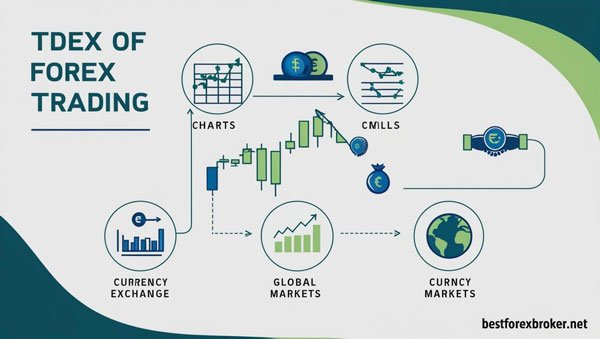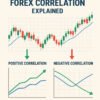If you’ve ever traveled to another country and exchanged your money for a different currency, you’ve already participated—on a small scale—in the foreign exchange market. But what exactly is forex trading, and how does it work?
In this guide, you’ll learn what forex trading is, how it operates, who participates, and whether it’s something worth exploring. Designed for beginners, this article explains everything in simple, practical terms.
What Is Forex Trading?

Forex trading (short for foreign exchange trading) is the act of buying one currency while simultaneously selling another, with the goal of profiting from changes in exchange rates.
You trade currencies in pairs, like:
- EUR/USD (Euro vs. U.S. Dollar)
- GBP/JPY (British Pound vs. Japanese Yen)
For example: If you think the Euro will go up in value compared to the Dollar, you buy EUR/USD. If it rises, you sell for profit.
⚠️ Forex is not a get-rich-quick scheme. It requires skill, patience, and a deep understanding of risk.
How Does Forex Trading Work?
Forex is traded in a decentralized, over-the-counter (OTC) market. That means:
- There’s no central exchange (like a stock market)
- Trades happen directly between buyers and sellers via brokers
- The market is open 24 hours a day, 5 days a week
There are four major trading sessions:
- Sydney
- Tokyo
- London
- New York
🔔 Beginner tip: The most active trading times are when sessions overlap, especially London/New York (13:00–17:00 GMT).
Forex trading is highly liquid and allows for significant leverage, which can magnify both gains and losses. That’s why proper risk management is essential.
Types of Forex Markets
The forex market can be broken down into three main types:
Spot Market
This is the primary forex market where currencies are traded in real-time. Trades are settled “on the spot,” usually within two days.
Forward Market
Here, contracts are made to buy or sell a currency at a future date at a specified price. This market is used mainly for hedging.
Futures Market
Similar to the forward market but with standardized contracts traded on exchanges like the Chicago Mercantile Exchange (CME).
⚠️ New traders usually start in the spot market because it’s the most liquid and accessible.
Common Forex Terms You Should Know
Before placing your first trade, it’s important to understand these basic terms:
- Pip: Smallest price movement (usually 0.0001 for most pairs)
- Lot: Size of the trade (standard = 100,000 units)
- Leverage: Borrowed capital to increase trade size
- Margin: Required capital to open a position
- Spread: Difference between the buy and sell price
- Stop-loss/Take-profit: Pre-set exit points for risk control
📅 Tip: Use demo accounts to familiarize yourself with these terms in real trading environments.
Currency Pairs Explained
All forex trades involve two currencies. The first is the base currency, and the second is the quote currency. For example, in EUR/USD:
- EUR = base
- USD = quote
If EUR/USD = 1.1000, it means 1 euro equals 1.10 U.S. dollars. If this number increases, the euro has strengthened.
There are three categories:
- Major Pairs (e.g., EUR/USD, USD/JPY)
- Minor Pairs (e.g., EUR/GBP, AUD/CAD)
- Exotic Pairs (e.g., USD/TRY, EUR/SGD)
🔹 Majors are recommended for beginners due to higher liquidity and lower spreads.
Forex vs. Stocks vs. Crypto
| Feature | Forex | Stocks | Crypto |
| Market Hours | 24/5 | Limited | 24/7 |
| Leverage | High | Low | Medium |
| Regulation | Strong | Strong | Weak/Varies |
| Volatility | Moderate | Moderate | High |
| Liquidity | Very High | Medium | Varies |
📊 Choose the market that fits your risk tolerance and style. Forex offers high liquidity but requires discipline.
How to Start Forex Trading

Getting started is easier than ever:
- Choose a regulated broker (FCA, ASIC, CySEC recommended)
- Open a demo account to practice risk-free
- Select a trading platform like MetaTrader 4 or MetaTrader 5
- Study the basics and develop a trading plan
- Switch to a live account when you feel ready
🔗 Looking for a good place to start? Read our Exness Broker Review or explore our Forex Basics Guide
Sample Trade Walkthrough
Let’s say:
- You buy EUR/USD at 1.1000
- You set your stop-loss at 1.0950 and take-profit at 1.1100
If the price hits 1.1100, you profit. If it drops to 1.0950, you limit your loss.
⚠️ Always use stop-loss orders to control risk. Never trade without them.
Mistakes New Traders Make
Many beginners lose money because they:
- Trade without a strategy
- Overuse leverage
- Chase losses
- Ignore risk management
- Don’t journal or reflect on trades
🔍 Success in forex is about consistency, not luck. Learn from every trade.
Is Forex Trading Right for You?
Forex trading isn’t for everyone. But if you:
- Enjoy learning and analyzing markets
- Are disciplined and patient
- Can handle risk and uncertainty
…then it might be a good fit.
📝 Write a trading plan and treat forex like a business.
Forex trading is the global exchange of currencies, allowing traders to speculate on exchange rate movements. It’s a dynamic, high-liquidity market open to anyone with a computer, internet connection, and curiosity.
If you are a beginner, take the time to learn the fundamentals, use demo accounts, and start small. With discipline and education, forex trading can become a powerful skill.
📌 Next steps: Read our What is Price Action or Best Forex Brokers for Beginners
FAQ: What Beginners Ask About Forex Trading
Is forex trading legal?
Yes, it is legal in most countries when done through regulated brokers.
Can I trade forex with $10?
Yes. Some brokers allow trading with as little as $5.
Is forex risky?
Yes. High leverage and volatile markets make it risky. Always manage your risk.
What platform should I use?
Most beginners use MetaTrader 4 for its simplicity and flexibility.
Can I trade forex on mobile?
Yes. Most brokers offer mobile apps with full functionality.












